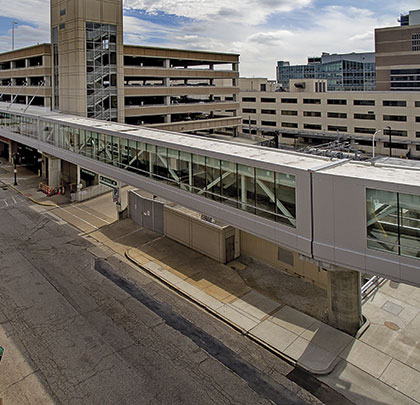KAI Design & Build, along with Joint Venture Partner Paric Corporation (KAI/Paric JV), completed a massive 1,200-ft-long, elevated pedestrian skywalk project connecting more than 6,000 parking spaces to the main hospital complex on the BJC HealthCare/Washington University Medical Center campus in St. Louis, Missouri.
KAI Design & Build’s construction department led the joint venture project, with KAI also providing its architectural design. The project is a component of the BJC HealthCare/Washington University Medical Center Campus Renewal Project—a long-term project to transform a 16-block campus that includes Barnes-Jewish Hospital, St. Louis Children’s Hospital, and the Washington University School of Medicine. The renewal project is focused on improving the patient and family experience from both a clinical and campus perspective.
PEDESTRIAN CONNECTOR
Completed in March 2017, after only 264 construction days, the extensive pedestrian connector is a 13-foot-wide tube elevated to heights averaging 40 feet above street level. It starts on the east end at the St. Louis Children’s Hospital staff garage and continues west along the MetroLink right-of-way adjacent to BJC’s new 3,022-space Duncan Central Garage, designed and constructed in 2015 by the Paric/KAI joint venture. The walkway then connects to a third BJC garage on Taylor Avenue and continues across Taylor Avenue to the west and runs alongside the 700-space Metro Parking Garage.
The 1,200-foot walkway ends at the new 12-story Mid-Campus Center where pedestrians can connect to the main elevated walkway system near the BJC Institute of Health and Hope Plaza. The recently completed Mid-Campus Center was also constructed by a joint venture between Clayco and KAI. Other buildings adjacent to the connector route include a 213,000-square-foot College of Pharmacy academic building (currently under construction), the existing College of Pharmacy, the Parkview Building, and the Eric P. Newman Education Center.
KAI’s architects designed the connector to blend in with its surroundings, withstand high pedestrian traffic and outside environmental factors such as wind and weather, and provide a comfortable, safe environment for its travelers.
DESIGNED FOR SAFETY
The connector is constructed of tinted, Low-E glass; pre-fabricated steel truss sections (in total weighing 380 tons); 14 concrete piers (2,500 cubic yards of total concrete); and over 500 sections of glass panels. Its mechanical system consists of a four-pipe, hot and cold water system that feeds local fan coil units with a couple of local above-ceiling air handlers.
The interior, which could not be completed until the connector was enclosed, incorporates field carpet tiles for its flooring and LED lay-in ceiling fixtures strung along its entire length. The bridge design also incorporates emergency exits, as well as emergency security intercoms (indicated by blue lights) at all garage and building points along its route.
“What we built was a controlled environment that provides a safe way to get from point A to point B,” said KAI senior project manager Jeremy Lammers. “It is a conditioned space so that in the summer, you are going to be cool and in the winter, you are going to be warm. In the rain, you are going to be dry. The connector provides a new way to get to work or class safely and comfortably.”
For security reasons as well as aesthetics, lights were installed roughly every 20 feet in the soffit beneath the bridge to illuminate the ground below and minimize the shadow effect cast from the bridge. The connector’s roof consists of an energy-efficient white, mechanically-fastened TPO roofing system.
COORDINATED COMMUNICATION
With multiple contractors/subcontractors and entities involved in the project at any given time, including the Washington University School of Medicine, St. Louis College of Pharmacy, MetroLink, various BJC HealthCare operational entities, as well as public utilities and the City of St. Louis, significant coordination was required by the KAI/Paric JV team to keep the project on track.
“Clear and regular communication with all of the entities was key to the success of the project,” says Lammers. “Covering roughly 7 acres of prime real estate on the eastern side of the largest medical campus in St. Louis, logistics were of the utmost importance. Daily communication with the building managers of several adjacent structures was key each and every day. Our crews had to not only avoid traffic congestion in the area as much as possible, but also work safely amongst the many people walking along the streets to get to the campus for work or school. It was quite a challenging project logistically, but the team did an outstanding job.”
KAI was able to achieve substantial minority inclusion on the project with 75 percent MBE and 1 percent WBE participation and reported only two recordable accidents on the project.
Power UP Electrical Contractors provided design/build electrical services on the project, with Square UP Builders providing rough and finish carpentry services.
ABOUT KAI DESIGN & BUILD
KAI Design & Build is a national 100+ person design and build firm headquartered in St. Louis, Missouri. A renowned leader in the industry, KAI provides design and build integrated project delivery solutions through collaboration, technology, processes, and expertise. Since its inception in 1980, KAI has been instrumental in reshaping the urban environment through its expertise in housing, K-12 schools, transit facilities, collegiate structures, commercial buildings, sports and recreational facilities, government/justice centers, and healthcare buildings. Beginning as an architectural design firm, KAI added mechanical/electrical/plumbing engineering to give clients a full package of in-house disciplines for their projects. Today, KAI continues with its original core service of design and has quickly grown its construction management group since 1997. Additionally, KAI is a leader in Building Information Modeling (BIM), applying the skill set to architectural, engineering, and construction projects firm-wide. ■
For More Information: For more information , visit www.turnerconstruction.com, or follow Turner on Twitter at @TurnerAlabama.
_________________________________________________________________________
Modern Contractor Solutions, June 2017
Did you enjoy this article?
Subscribe to the FREE Digital Edition of Modern Contractor Solutions magazine.

Only 264 Construction Days


